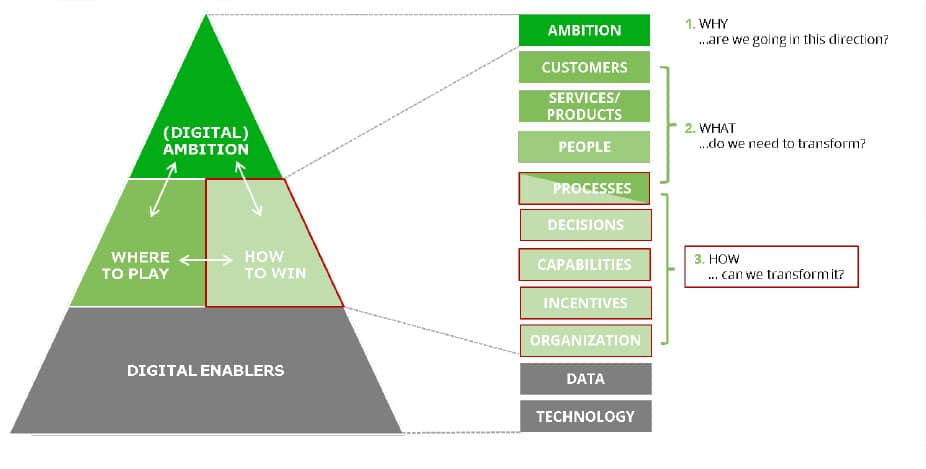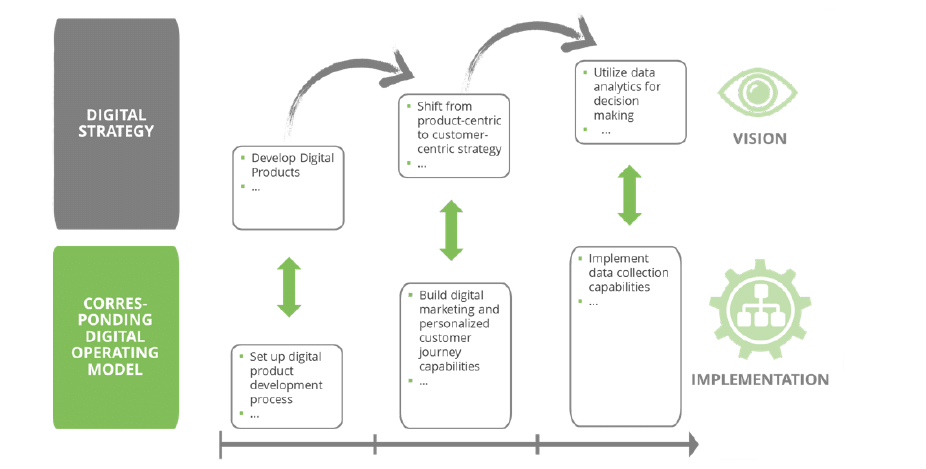The need for a digital operating model
The operating model needs to be put into the overall strategic context of the firm. Starting with a clearly framed digital ambition, a digital strategy defines the where to play and how to win the game. The where to play defines which (digital) products and services should be offered to which customers and – as an extension to the classical version – which people the company wants to be an attractive employer for. All this needs to be transformed as part of a digital strategy. Where to play involves clear choices on what elements a firm needs to transform or re-focus to realize the strategy: customers, services/products, people and processes. The how to win defines which specific approach should be taken to achieve success vs. the competition and is in line with the operating model elements.
Processes, decisions, capabilities, incentives and organization constitute the operating model, bridging the digital strategy with the dgay-to-day-operations. Given this constellation, it is a logical consequence that the design of the operating model is deeply linked with the digital strategy. This might be why many experts advise their clients to select just one specific type of operating model according to their strategic goals such as the customer centric model, the data powered model, or the open & liquid model (as seen at e.g. Accenture, Deloitte, Ernst & Young, World Economic Forum). However, this approach falls a bit short in our view. In our experience, it is not about choosing one operating model approach, but rather about evolving the operating model in line with the short and the long-term milestones. Instead of aiming at following just one digitalization goal such as customer centricity or data-enabled business model, companies actually should strive for all of these goals over time – in different stages over a certain time horizon, depending on a company’s individual digital maturity state, market situation and resources. This allows for tailoring the digital operating model individually to the firm’s situation, while following digital innovation blueprint principles. The visual below shows the relationship between digital strategy and the corresponding digital operating model, its suggested evolution over multiple stages or periods and some examples of digital strategy and operating model adustments we regularly see in companies.

Processes, decisions, capabilities, incentives and organization constitute the operating model, bridging the digital strategy with the dgay-to-day-operations. Given this constellation, it is a logical consequence that the design of the operating model is deeply linked with the digital strategy. This might be why many experts advise their clients to select just one specific type of operating model according to their strategic goals such as the customer centric model, the data powered model, or the open & liquid model (as seen at e.g. Accenture, Deloitte, Ernst & Young, World Economic Forum). However, this approach falls a bit short in our view. In our experience, it is not about choosing one operating model approach, but rather about evolving the operating model in line with the short and the long-term milestones. Instead of aiming at following just one digitalization goal such as customer centricity or data-enabled business model, companies actually should strive for all of these goals over time – in different stages over a certain time horizon, depending on a company’s individual digital maturity state, market situation and resources. This allows for tailoring the digital operating model individually to the firm’s situation, while following digital innovation blueprint principles. The visual below shows the relationship between digital strategy and the corresponding digital operating model, its suggested evolution over multiple stages or periods and some examples of digital strategy and operating model adustments we regularly see in companies.

The link between digital strategy and operating model evolves over time and occurs in a multi-stage process. The first strategic milestone is typically to deliver digital products, as we observe in many companies now working to become more digital. The operating model has to align with this target by aligning the respective DIPOC elements, e.g. the digital innovation or product development process that now needs to embed digital elements. Decision makers need to follow a new decision making logic, now involving more functions much earlier in the process (e.g. digital marketing already when designing the product). Knowledge capabilities have to be built, etc. In the second phase, companies typically shift from product-centricity to strengthening customer-centricity. This shift leads to further changes in the operating model, e.g. adapting and customizing the customer journey (processes and decision making). Once this is achieved, the strategy moves on to full-scope data analytics utilization. Thus, the operating model has to take care of implementing data collection capabilities and a further revised and more data-based decision making logic. This continuous alignment between digital strategy and operating model continues until some level of a digitalization vision is achieved – and beyond, as the business will further evolve.



